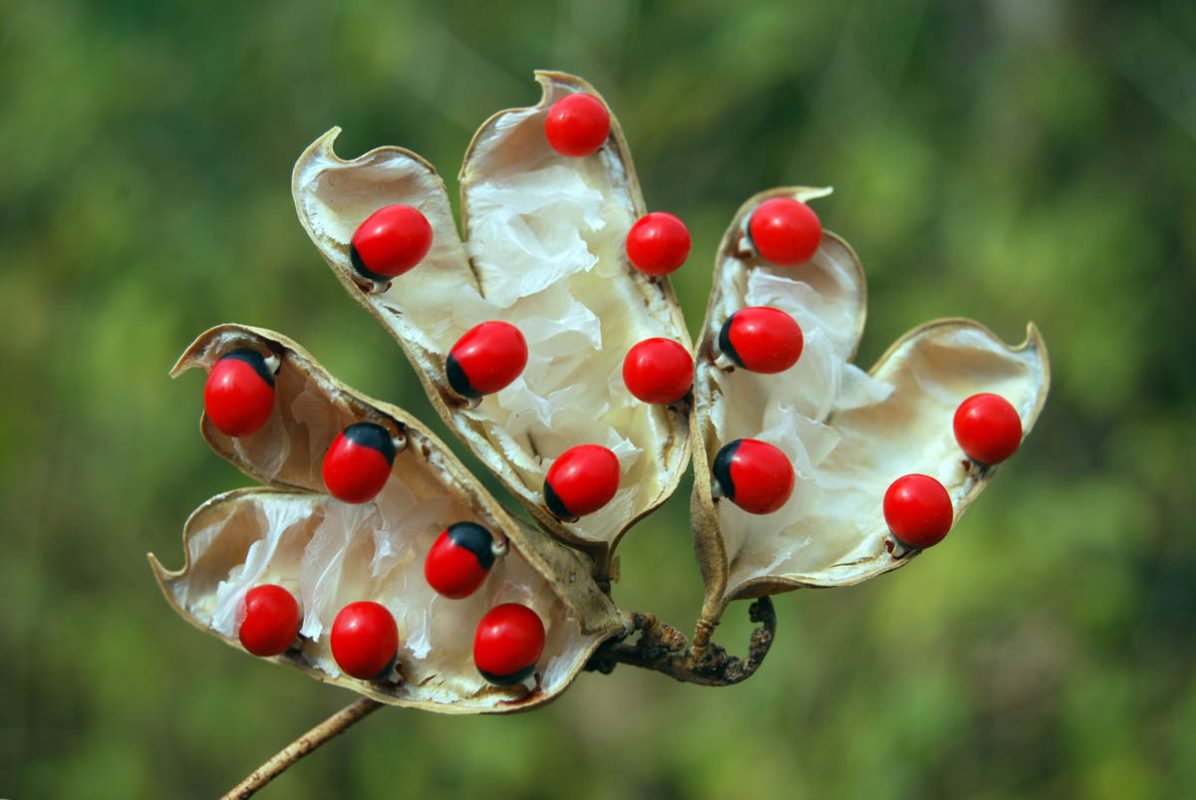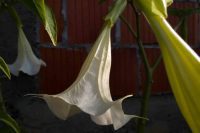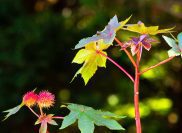What is abrin?
Abrin is a ribosome-inactivating protein (RIP) found in the seeds of the rosary pea (Abrus precatorius L.), family Fabaceae. The rosary pea is a herbaceous flowering plant in the legume family, native to Africa, Madagascar, India and Indo-China. The black and red beans have been used to make jewellery in some cultures. The seeds are often strung together to create necklaces and bracelets, and their small size and colourful appearance make them popular for decorative purposes.
Abrin is a secondary metabolite, which is an organic compound produced by plants that are not involved in growth or reproduction. It serves as a defence mechanism against herbivores and pathogens.
A better-known toxin is ricin, which is produced by the castor oil plant (Ricinus communis). Both abrin and ricin inhibit ribosomal protein synthesis, however, abrin has been found to be 75 times more toxic to mice than abrin.
The name ‘abrin’ is derived from the scientific name of the plant that produces it, Abrus precatorius. Abrus is derived from the Greek word ‘ἀβρός‘, which means delicate, in reference to the leaflets. Precatorius means ‘petitioning‘ in reference to the use of the peas in rosary beads.
About Abrus precatorius
| Common names | Rosary pea, Crab’s eye, Jequirity, Paternoster pea, Love pea, Precatory pea, Prayer bead, Coral bead, Red-bean vine, Country licorice, Wild licorice, Jamaica wild licorice, Akar saga, Gidee gidee, Ratti, Gunja, Weather plant, Deadly crab’s eye, Indian bead |
| Scientific name | Abrus precatorius L. |
| Family | Fabaceae |
| Plant type | Perennial climbing vine |
| Mature height | 1.5 – 3 metres |
| Flower colour | White or pink |
| Leaf colour | Green |
| Berry colour | Red and black |
| Toxicity | Toxic |
| Toxic properties | Abrin |
| Severity | Severe |
Abrus precatorius is a slender climbing vine native to the Indian subcontinent and West Indies but is now endemic to temperate and tropical regions of the world. The rapid growth rate, ability to sucker and a deep root system make A. precatorius a challenge to eradicate and it has been declared an invasive species in many areas.
Leaves: The glossy green, pinnately compound leaf is made up of several leaflets, arranged opposite each other on a central stem (rachis). Each leaflet is typically 2 – 4 cm long, oval, tapering to a pointed tip and a smooth margin, which gives it the appearance of a feather. The prominent midrib and lateral veins are visible on both upper and lower leaf surfaces.
Flowers: The 1 cm pink papilionaceous (shaped like a butterfly) flowers are borne in clusters at the tip of the branches and bloom in summer. Bees and other pollinators are highly attracted to sweetly scented flowers.
Seeds: After pollination, pods develop that are 2 – 4 cm long and contain the plant’s bright red seeds with a black eye at the hilum (where the seed was attached to the pod). Birds disseminate the brightly coloured seeds, which pass through the bird’s digestive tract intact.
Mechanism of action
The toxic principle is abrin, a lectin, which is found in the pea of the plant. Lectins are proteins found in plants that bind to specific carbohydrates and play vital roles including protecting plants against pathogens. Ingestion of just one bean can be fatal, however, the hard shell makes the bean safe to touch.
Abrin consists of two polypeptide chains; the α-chain (called an ‘effectomer’) and the β-chain (called a ‘haptomer’) which are linked by a disulphide bond. The β-chain binds to specific cell surface receptors, undergoing receptor-mediated endocytosis (a process in which the cell produces a vesicle and engulfs the substance), which allows the entire abrin molecule to enter the cell.
Ribosomes are small structures that read RNA instructions and use them to assemble proteins. Once inside the cell, the α-chain depurinates (the removal of purine bases) the adenine residue in the ribosomal RNA in cells, leading to the inactivation of the ribosome, inhibition of protein synthesis and ultimately cell death.
Abrin can also activate caspases, which are enzymes involved in apoptosis (programmed cell death) due to the inhibition of protein synthesis. This lack of new protein synthesis causes an accumulation of misfolded proteins and the activation of stress pathways within the cells. It is these stress pathways that lead to the activation of caspases, and the induction of apoptosis.
As abrin is simple to purify from the seeds and can be stored as a dry powder, it is a potential threat to bioterrorism.
Abrus precarious uses
In addition to its use as a poison, rosary pea has also been used in traditional medicine to treat various ailments, including fever, cough, diabetes, boils, sores and acne scars.
- Jewellery: Rosary pea has also been used for decoration and jewellery-making. The seeds of the plant have a distinctive black and red colouration, making them popular for use in beads and other ornamental objects. However, it’s important to note that handling the seeds can be dangerous, as the toxin can be absorbed through the skin.
- Medicinal: Despite its high toxicity, abrin has been explored as a potential anti-cancer agent due to its ability to selectively inhibit protein synthesis in cancer cells. However, its use in cancer therapy is limited by its non-specific toxicity to healthy cells and the difficulty of delivering it specifically to cancer cells.
- Traditional medicine: The roots and leaves of Abrus precatorius are used as an aphrodisiac and in traditional medicine to treat coughs, asthma, bronchitis and tuberculosis. After a detoxification process, abrin is used in Ayurvedic medicine as an anti-inflammatory, analgesic, abortifacient and CNS depressant.
Due to the extremely toxic nature of abrin, children and pets should not have access to jewellery that is made of rosary peas.
Abrin as a biosecurity threat
The deadly nature of abrin and ready availability makes it a risk for bioterrorism.
- The Centers for Disease Control and Prevention (CDC) classify abrin as a ‘Select Agent‘, which means its use in a laboratory is subject to strict safety and security regulations.
- In the UK, the use and possession of toxins such as abrin are regulated under the Anti-terrorism, Crime and Security Act 2001. It is illegal to possess, control, transport, make, or use any dangerous substance without a legitimate reason.
- The Australian Department of Foreign Affairs (DFAT) lists abrin as a toxin that is subject to strict export control.
Despite these regulations, there have been cases of individuals attempting to use abrin for harmful purposes. Therefore, continued vigilance and regulation are critical to prevent the misuse of this potent toxin.
Symptoms
The clinical signs of abrin toxicity vary on the route of exposure, the dose and the health of the patient. Inhalation and injection elicit a faster response than ingestion of the same dose. Symptoms typically develop within 8 hours of exposure, but it can take as long as three days.
Gastrointestinal
The first cells to be affected are the cells that line the gastrointestinal tract. Some of the toxin passes through the wall of the small intestine and into the circulatory system, causing widespread organ failure.
- Abdominal pain
- Diarrhea
- Nausea
- Loss of appetite
- Vomiting
- Gastric ulcerations and hemorrhages
- Dehydration
Inhalation
When inhaled, abrin enters the body via the respiratory system, binding to the surface of the alveolar epithelium, where it inhibits protein synthesis. Once in the lungs, abrin enters the bloodstream through the alveolar-capillary membrane and is carried to other parts of the body, where it causes organ failure.
- Dyspnea (difficulty breathing)
- Coughing
- Chest pain
- Fever
- Muscle aches
- Hypoxemia (low levels of oxygen in the blood)
- Cyanosis
- Pulmonary edema
General
- Dehydration
- Fever
- Weakness
- Lethargy
- Muscle pain
Diagnosis
A diagnosis of abrin toxicity is based on a history of exposure, presenting symptoms as well as diagnostic tests which will include blood and urine tests to test organ function.
- Enzyme-linked immunosorbent assay (ELISA): The ELISA test uses abrin-specific antibodies to detect the toxin in a biological sample.
- Polymerase chain reaction (PCR): This test amplifies small segments of DNA and is used to amplify and detect regions of the abrin gene.
- Animal bioassays: The suspected toxin is injected into laboratory animals to monitor their response. This method can be used to confirm the presence of abrin in a sample. It is not commonly used due to ethical concerns.
Treatment
Seek immediate medical care if you, a family member or a pet have had any exposure to abrin. There is no antidote to abrin poisoning and treatment is aimed at managing symptoms.
- Gastric decontamination: If abrin was ingested recently, the doctor can induce vomiting or gastric lavage (flush the stomach) to remove the toxin from the gastrointestinal tract. This will be followed by activated charcoal to bind to any remaining toxin.
- Respiratory support: Oxygen therapy or mechanical ventilation for inhaled abrin exposure to managing respiratory distress.
- Symptomatic treatment: Depending on the severity of symptoms, the patient may require hospitalisation and supportive care. This may include fluid therapy and electrolytes to treat or prevent dehydration and electrolyte derangements. Antiemetics for nausea and vomiting. Analgesics and anti-inflammatory medication to treat pain and inflammation.
Conclusion
- Abrin is a highly toxic protein produced by the rosary pea or jequirity pea (Abrus precarious).
- Ricin and abrin are similar toxins, both inhibit ribosomal protein synthesis which leads to cell death.
- The peas of A. precarious are commonly used as jewellery.
- Due to the extreme toxicity of A. precarious, avoid all contact with this plant, especially the beans.
- Seek medical attention immediately if exposed to abrin.
Julia is a writer and landscape consultant from Wollongong with a love of horticulture. She had been an avid gardener for over 30 years, collects rare variegated plants and is a home orchardist. Julia is passionate about learning and sharing her knowledge of plant propagation and plant toxicology. Whether it’s giving advice on landscape projects or sharing tips on growing, Julia enjoys helping people make their gardens flourish.




